Dismissed after a disastrous spell at Real Madrid which humiliated him, Julen Lopetegui’s stock was pretty low come the turn of 2019 in Spain.
Having progressed through his career with a specific philosophy, he found himself abandoning his World Cup dream and then being chased out of Real Madrid after a few months.
When he took charge of Sevilla in 2019/20 following another summer of heavy turnaround at the club, the jury was certainly out.
Yet, Lopetegui has adapted. The innovative use of wing-backs in his system has marked a significant change from his time throughout the rest of his career.
Blessed with two of the best in the country in Jesús Navas and Sergio Reguilón, Lopetegui has built a team which has, to a certain extent, gone back to basics.
This Julen Lopetegui tactical analysis will identify how Lopetegui has looked to use these wing-backs to bring success to Sevilla.
Building around the tactics of the full-backs, this analysis will consider how Sevilla have climbed into Spain’s top four and have even looked to threaten La Liga’s dominant big three.
Lopetegui’s central defensive options
In order to use wing-backs effectively, particularly while deploying a four man defence rather than a five man defence, Lopetegui has clearly worked closely with Monchi to acquire the players required for this system. Under Pablo Machín last season, a back three was used to allow wing-backs to operate freely, but upon his appointment Lopetegui almost entirely wiped out the defensive options. Daniel Carriço, Simon Kjaer and Gabriel Mercado have all been shipped out while Sergi Gómez has seen his role significantly reduced in terms of game time. These players, all over 30 in age other than Gómez, lacked the pace to fit into Lopetegui’s system.
That was why the club spent big money to bring in Diego Carlos, hailed as one of the best signings of the season, and Jules Koundé. Between the two, there have only been seven games in which they have not both been involved and they have been the leaders in Sevilla’s defensive line. Their pace and strength has meant that when a wing-back pushes up, they can react quickly and cover.
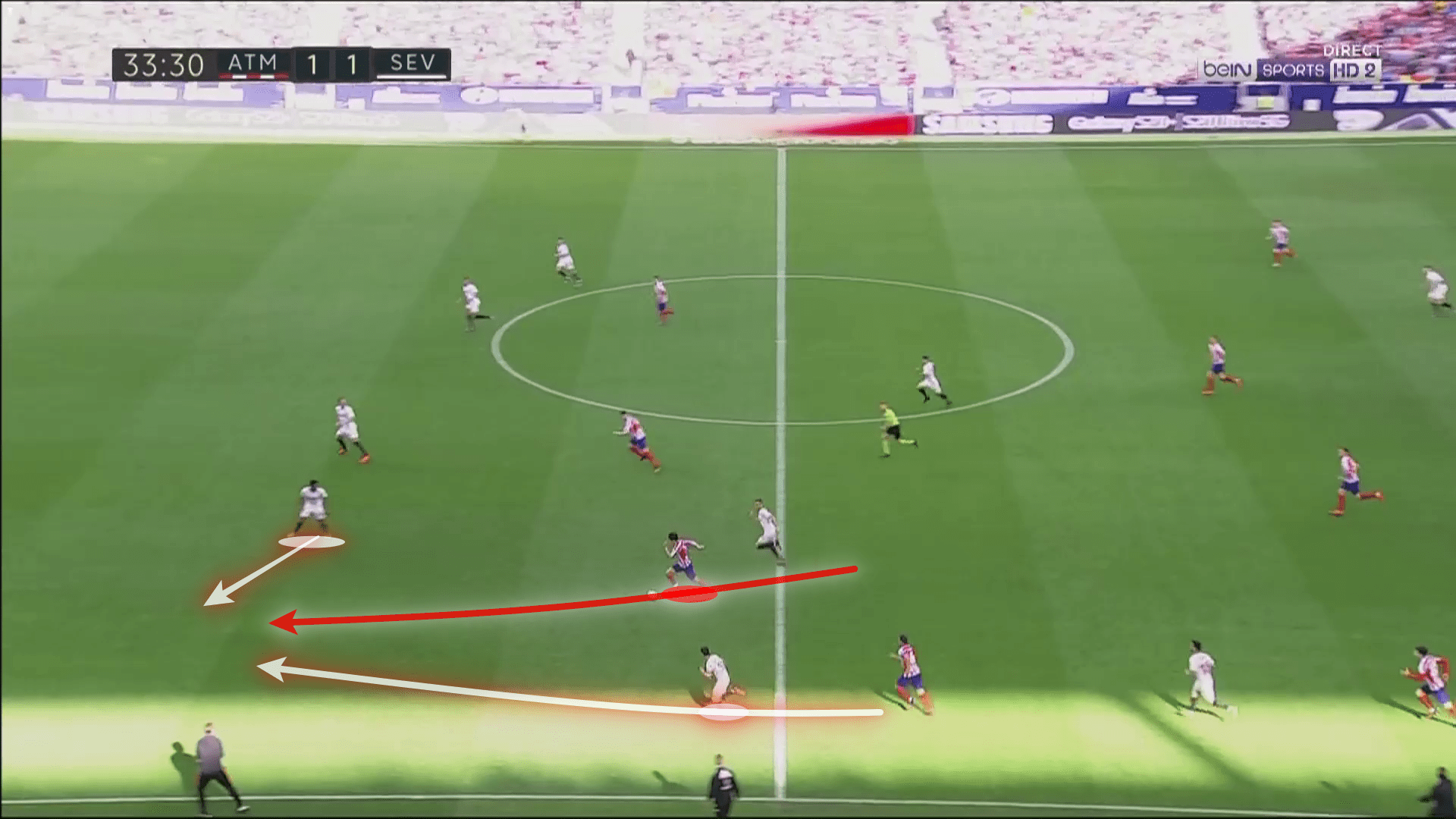
This can be seen here as Atlético Madrid looked to counter, with Navas caught high up the field and out of position. Immediately, Koundé alters his body positioning to show João Félix into a narrow channel where either he or Navas will be able to win the ball from him. As midfielders drop to cover him, Koundé can step out and go wide without fear of a central runner. In the end, Koundé won the ball back easily and could switch the ball towards the left flank and set Sevilla on their own attack.
The alternative option, which Lopetegui does use regularly, is to drop a central midfielder into the back line. This is evident in this example against Barcelona, where Fernando would regularly drop in to act as a third central defender, rather than form part of a double pivot. This shows the importance of flexibility within Lopetegui’s players. By having this ability to drop in to become a third central defender, Sevilla have a dynamic system of players swapping and interceding into other roles dependent on the movement of their team-mates.
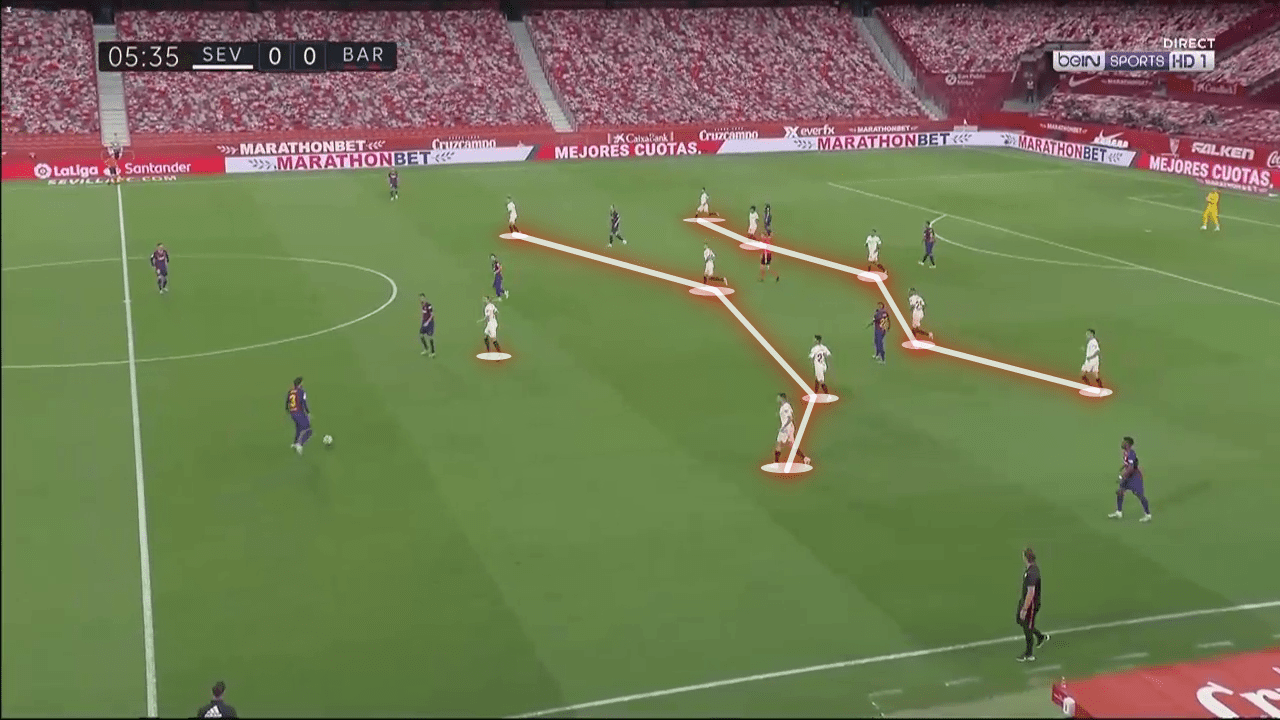
Again here, Fernando is effectively the only option who Lopetegui relies on and is the midfielder with the most minutes played by some distance, having played 9.75% more minutes this season than Joan Jordán. However, against strong opposition like Barcelona, as can be seen here, it gives Sevilla the chance to drop into a back three when out of possession and produce a rigid structure with very little space for movement from opposition forwards.
The role of the wing-back
As can be seen by this fluid and flexible defensive shape deployed by Lopetegui, the role of the wing-back within this set-up can diversify significantly. Within this analysis, we will consider the roles of Navas and Reguilón, who have been the full-back pairing for 77.6% of minutes played by Sevilla this season.
Served by midfield playmakers like Éver Banega and Joan Jordán, they can pick out a pass to the wide areas with ease and immediately look to Navas and Reguilón to be bombing forward in order to exploit the space ahead of them and then redirect the ball centrally in order to create a goalscoring chance for the team.
With central defenders and a holding midfielder providing cover in behind, they can do so without the concern for their defensive responsibilities. Here, we will take a look at the strategy behind the two first choice defenders on either flank.
Jesús Navas
Previously a winger by nature, Navas is a legend at Sevilla. Not only has he spent the vast majority of his career at the club, even having a training ground named after him, but he is also the club’s leader. His importance within the team is clear for all to see and his role in the transition is what keeps Sevilla ticking at times, with his progressive runs and dribbles which immediately take the ball forward.
What is impressive about Navas is not only that he takes the ball forward instantly down the flank but that he also draws in opposition players. Timing his run well to stop and slow down, it allows his team-mates to catch up with play, where he can then draw in opposition midfielders and defenders, as can be seen here against Espanyol, which allows other forwards within the Sevilla team to capitalise on the spaces opening up and the midfielders to move forward.
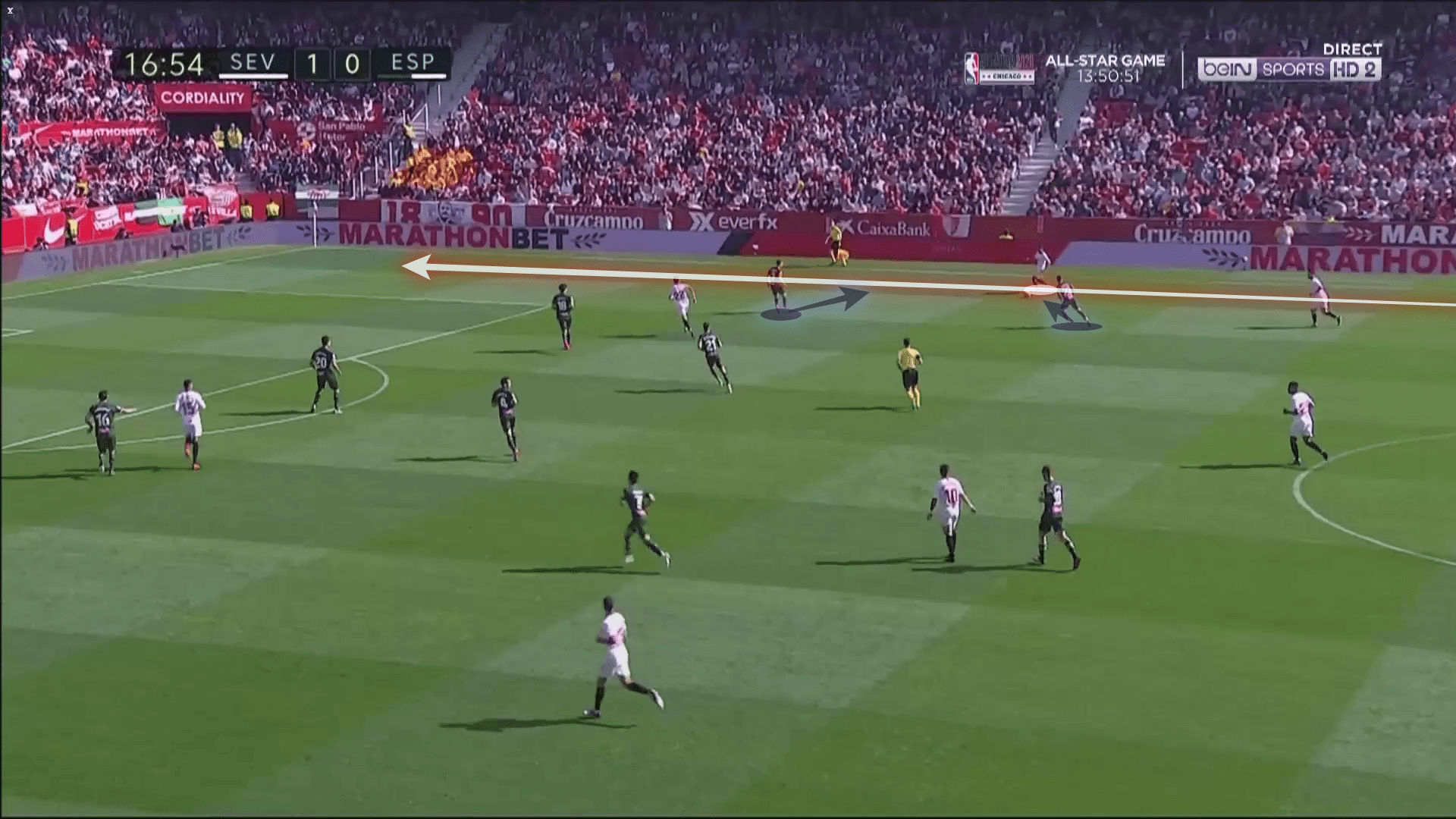
Covering such ground, with such pace, at the age of 34 is a remarkable feat for any player, let alone one who has spent his career at the top as has been the case. By creating such space, he allows Sevilla not to be entirely dependent upon their centre-forwards for goals, as will be touched upon later, as the legwork of Navas to exploit the wide areas and draw away attention opens up space for midfielders to push forward.
Equally, we cannot consider the form of Navas without looking at his crossing as no-one in La Liga has more crosses than the 7.04 per 90 minutes which he registers on average, effectively leading the way for the team which has the most crosses in La Liga. Here, he will often look to get to the final third before playing in a cross and, when not carrying the ball himself, will overlap with another Sevilla forward, as is the case below, to deliver a cross from deep.
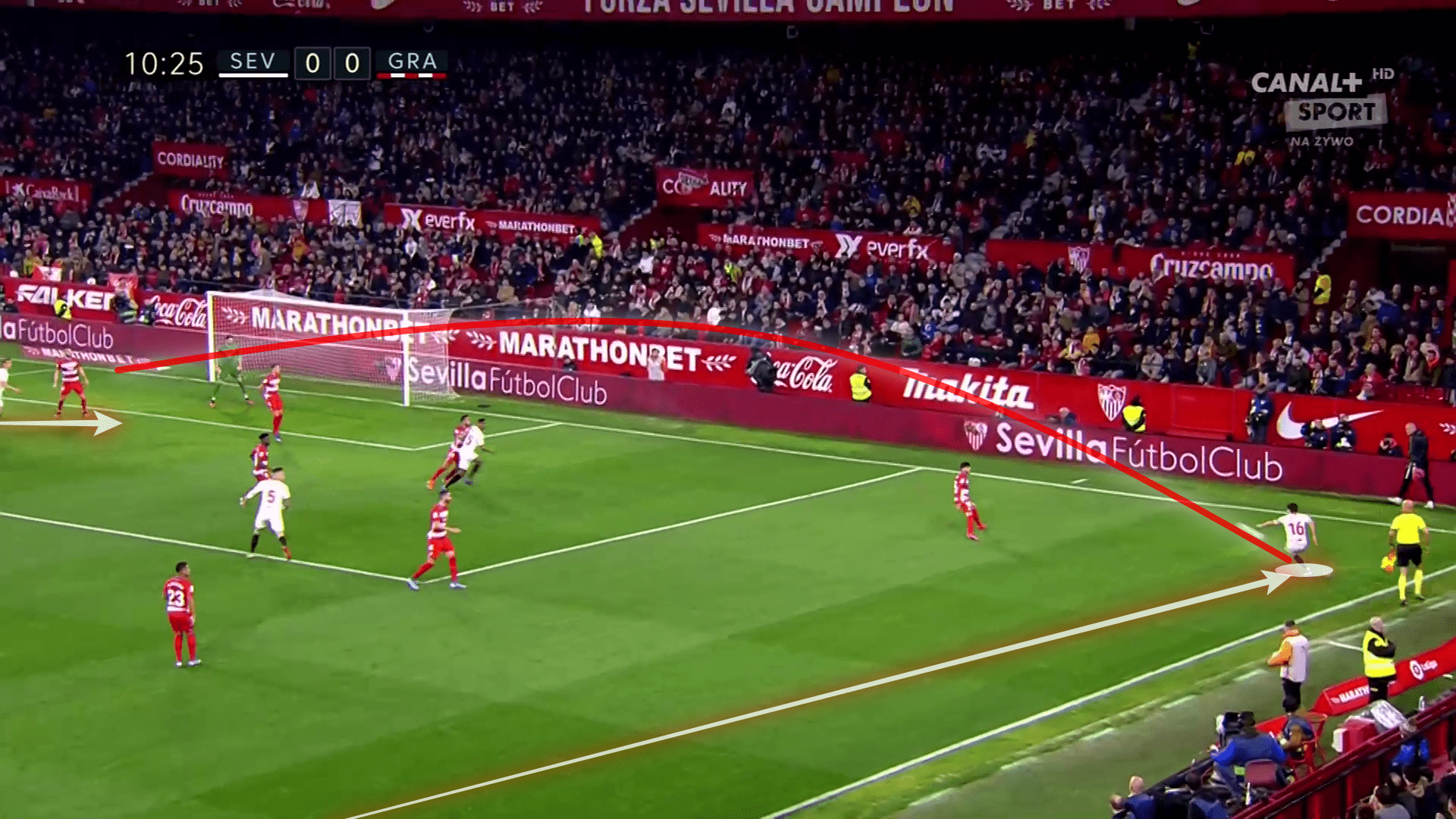
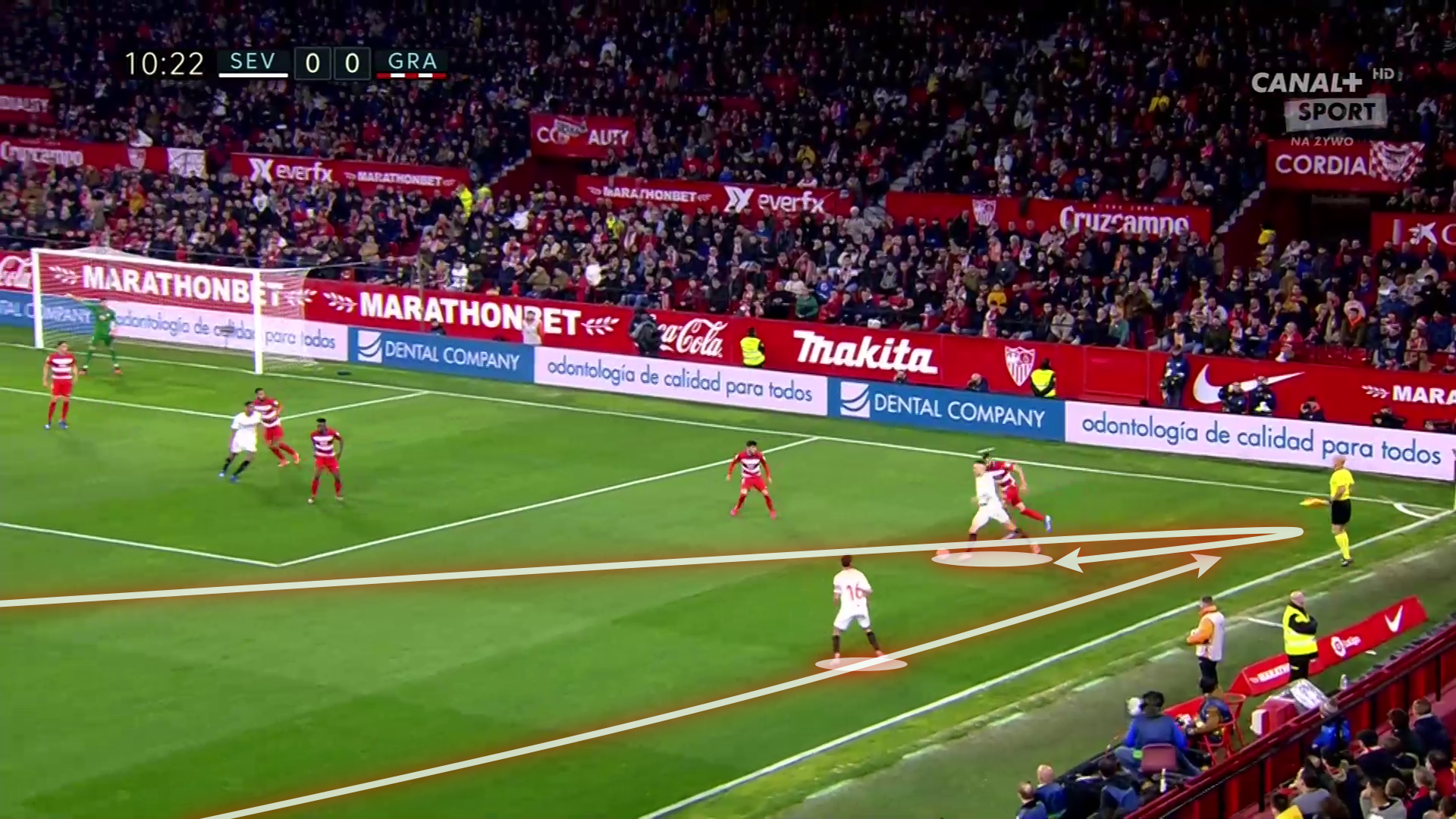
His crossing accuracy of 35.6% is again important to note here as Navas provides a clinical and efficient option. He has become one of Sevilla’s predominant attacking threats through this approach and we have repeatedly seen opposition teams look to pin Navas back.
If there is one area where we could ask for more from Navas, it could be in how he performs against strong opposition. Against the likes of Barcelona and Real Madrid, Navas is far more disciplined and does not make so many daring runs forward, as such reducing Sevilla’s attacking options. While this discipline is essential defensively, it was clear against the likes of Barcelona that as they played such a narrow set-up, Navas could indeed have gambled and exploited the width more regularly. Without the ability to do so physically, or perhaps the fear of getting caught out, Sevilla were left with a more blunt attack as they did not have Navas bombing down to the final third and getting down to the touchline.
Sergio Reguilón
On the opposite flank, it is quite the opposite. Rather than bombing down to the touchline, Reguilón operates in a more cautious way, which we could perhaps expect given his track record with Lopetegui. Reguilón was also called up to Real Madrid’s first team for the first time under Lopetegui but did not feature regularly. When he did, he was selected as a more defensive alternative as opposed to Marcelo. Now at Sevilla, Reguilón is afforded more of the left-flank but does look to press higher up to defend and links up well with other attackers in a more structured team move, relying less on individuals and more on team shape and movement than was the case at Real Madrid in 2018/19.
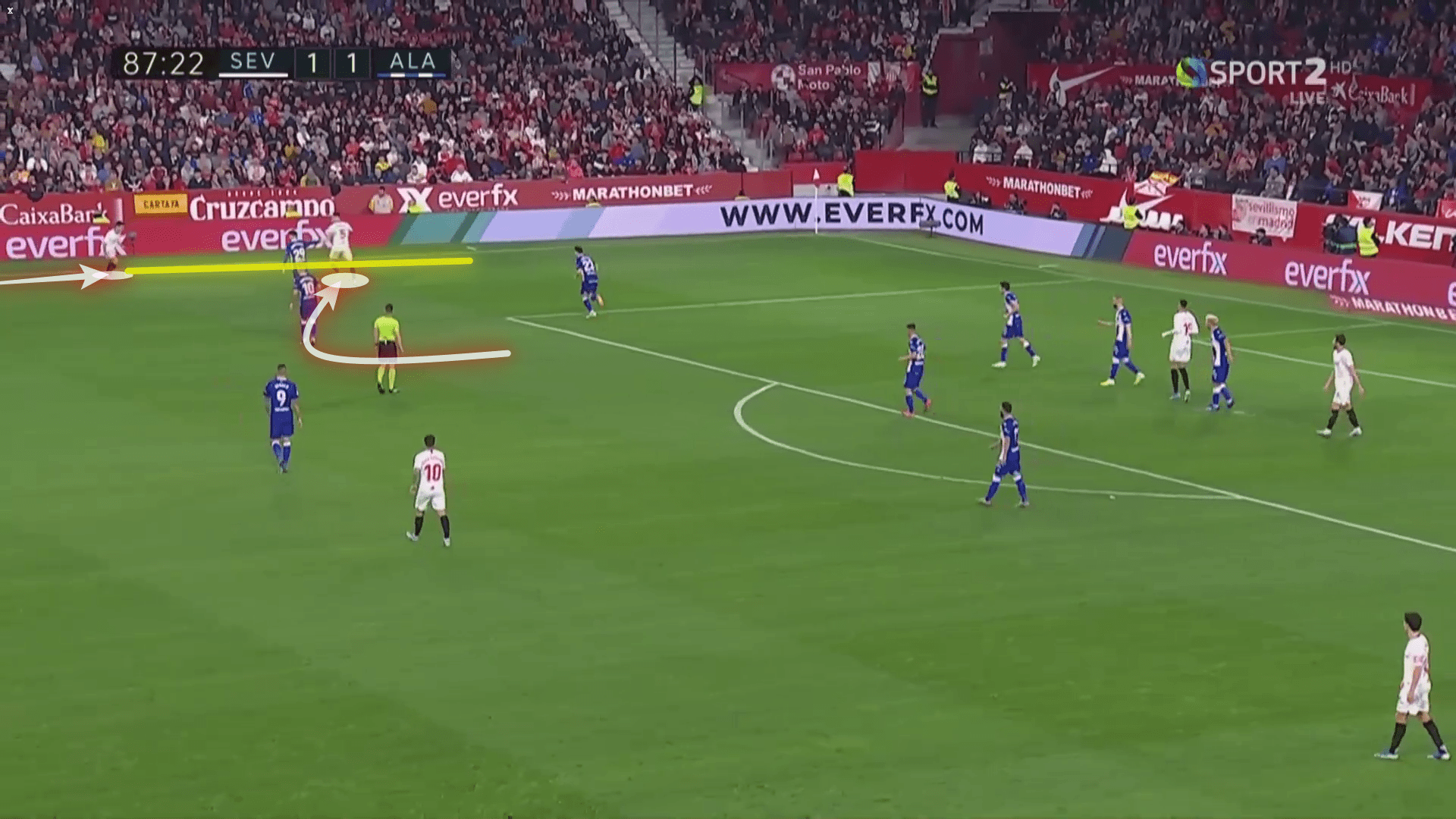
However, one of the key differences between the two lies in that Reguilón does link up more regularly with the forward players on the left flank. While he does carry the ball forward and is just as threatening on the ball, he lacks the pace and direct threat that Navas possesses on the right. Instead, Reguilón will take the ball up to the final third and will then regularly look to lay the ball off to Lucas Ocampos or another forward making a wide run to create space in the middle.
Perhaps this explains why his crossing accuracy is slightly higher than Navas, at 37.9%, with a lower volume, at 5.32 crosses per 90, as he tends to sit deeper to play his crosses into the box and will connect with those around him more freely. At times, this does lead to more overcrowding in the penalty area and while this may lead to a higher cross accuracy, the end xG of the chances he creates are lower, with 0.18 xA (expected assists), compared to the narrowly higher 0.2 xA for Navas.
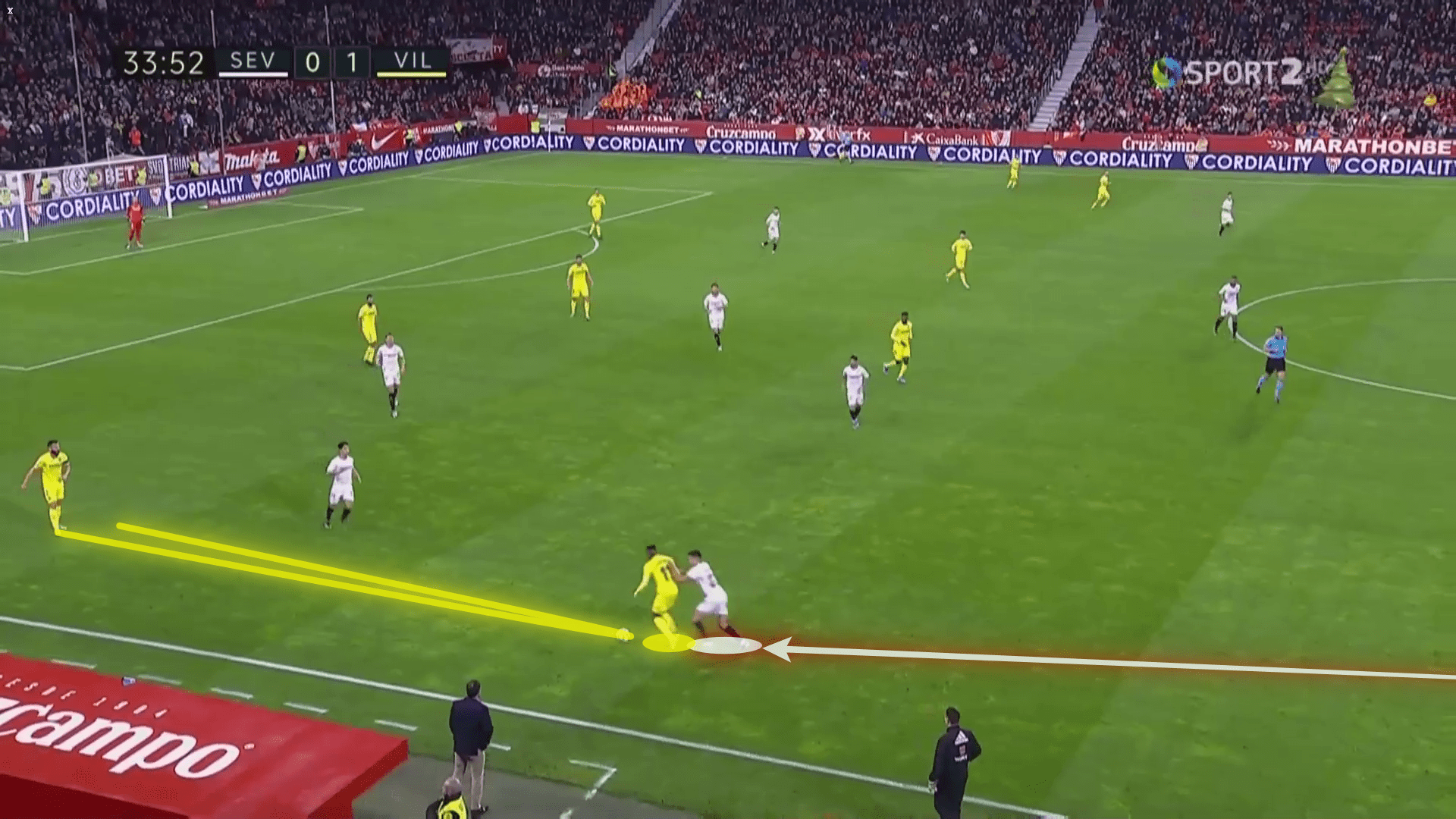
Another significant difference, when compared to Navas, is that Reguilón will push up the field and look to defend higher up the pitch. This can be seen here against Villarreal, where Reguilón moves up to press high and prevent attacks at their source. On the opposite flank, Navas will tend to only get forward in this way when in possession, rather saving his limited energy in order to create a threat.
Reguilón will push up in defensive scenarios too, which brings another dimension to Sevilla’s backline. This, in one of the few differential areas between the two wing-backs, is where we can perhaps identify that Reguilón would be classed as more of an attacking-minded full-back, rather than an out-and-out wing-back, instead preferring to sit deep and push up whether offensive or defensive, while Navas will keep his position until Sevilla are on the ball and then immediately look to spring into the space on the right.
Target men strikers
It has been clear in Sevilla’s transfer policy, led by Monchi, that the club are after traditional target men in attack. It has also become evident that Sevilla will not depend upon them for goals as of the 10 players to have amassed more than 2.0 xG this season, only three of them have been centre-forwards.
Luuk de Jong has proven to be rather ineffective in his role, underscoring his xG by a substantial 3.89, and this led to the decision to bring in Youssef En-Nesyri from Leganés in January for 20 million euros. En-Nesyri has been more clinical but lacks the work-rate to create issues for opposition defenders that De Jong does by pulling open spaces.
A good example of the Dutchman’s movement can be seen here against Levante, where he arrives late into the box as is often the case and immediately makes a run towards the edge of the six yard box between the two central defenders. This run has become typical of him and his link with Navas is clear as they will often combine to provide this cross for De Jong to convert the header. In total, a third of his goals this season have come through this exact move.
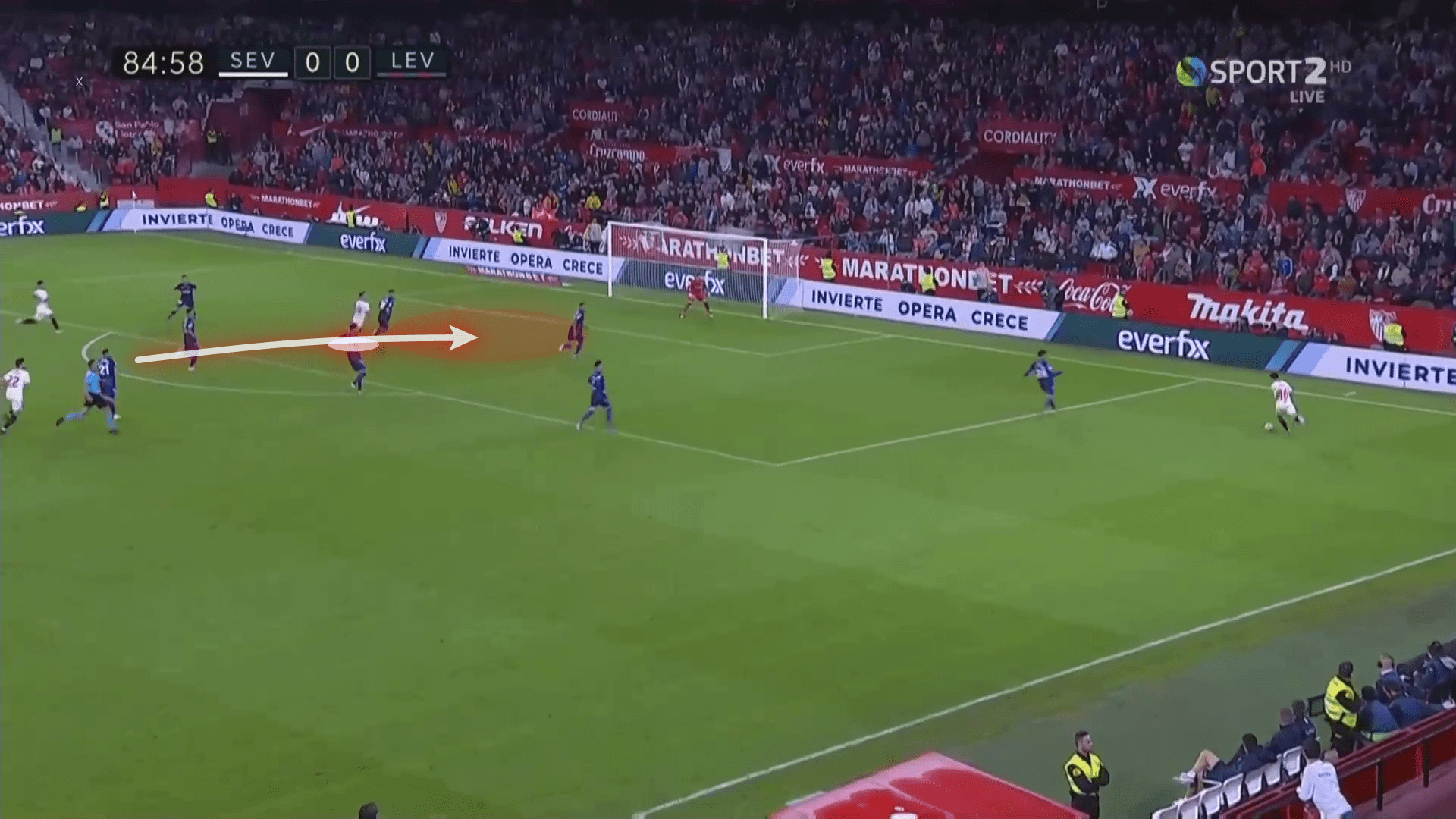
These figures are then supported on the flanks. This is where players like Munir El Haddadi, Lucas Ocampos and at the start of the season, Nolito, who has now moved on to Celta Vigo, come into play. With opposition central defenders preoccupied trying to prevent the aerial strength of De Jong or En-Nesyri, they can find space, usually at the far post, to capitalise.
Munir provides an ideal opportunity to analyse such a chance against Villarreal, where the opposition defenders were so focused upon preventing En-Nesyri from winning the aerial challenge as Navas delivers the cross, that Munir could drift off to the far post in space and volley an effort into the back of the net to equalise.
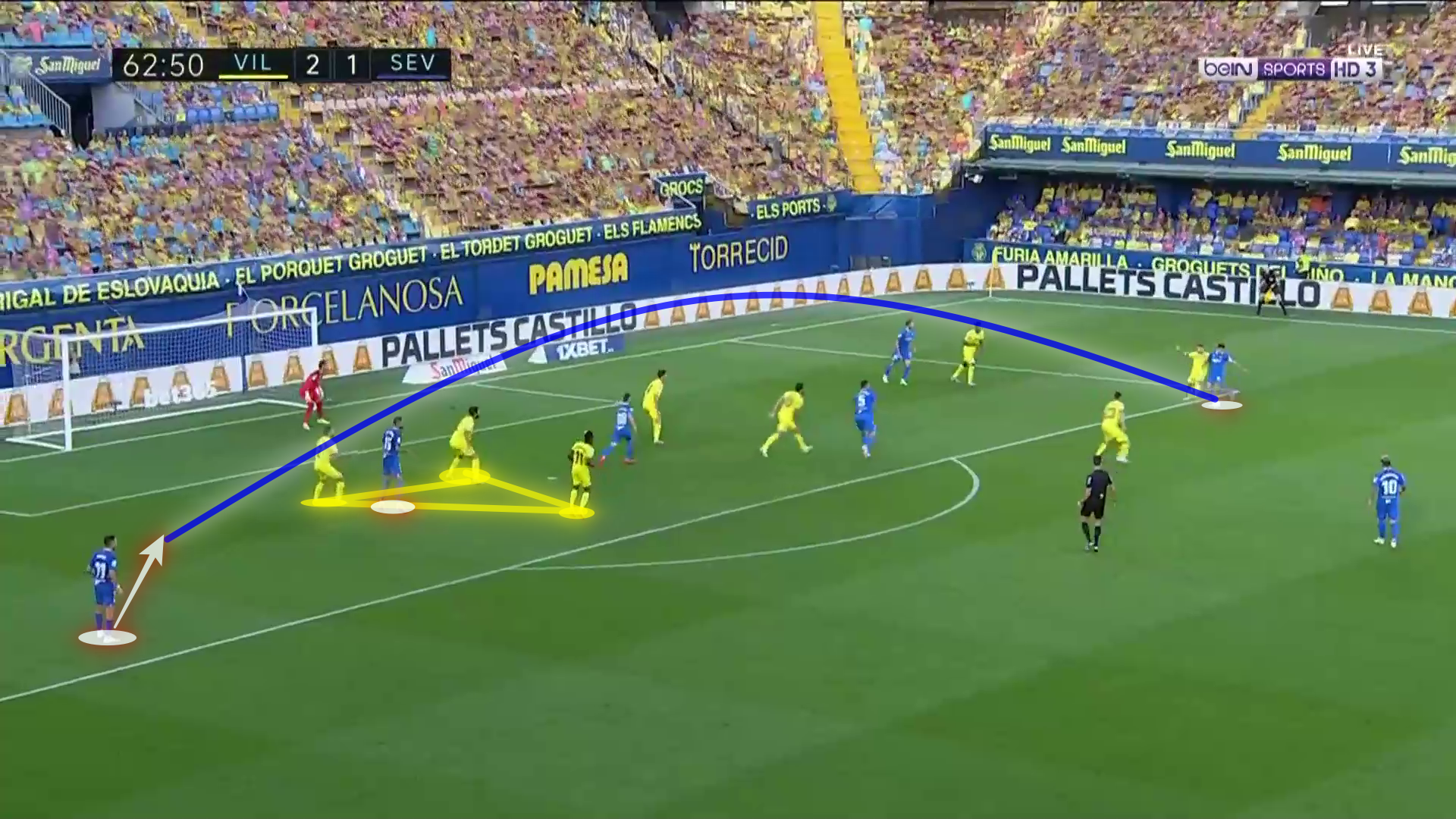
This reliance upon different moving parts within the Sevilla attack shows the dynamism of this whole approach. From the movement of the central defenders to cover right through to the wingers looking to exploit space at the far post, Lopetegui has created a free-flowing system in which the movement of each individual has an impact.
Conclusion
Lopetegui’s new approach and this dynamic use of attacking full-backs has proven that Sevilla can build a strong philosophy built around a system and the team. It has proven to work well, particularly in an area where La Liga’s big teams are lacking the world class full-backs like Dani Alves, Marcelo at his peak, Filipe Luis, and more, who would have once dominated the game.
However, long-term, it is evident that Sevilla must invest in order to make this approach work. It has already been seen this season that consistency has been a real struggle and that the team have lacked a lethal centre-forward who can help them to exceed their xG, rather than underscore it by 3.09. That alone has cost them 2 points this season.
What is more concerning though is the lack of options within Lopetegui’s squad and this is the real cause of inconsistency. Navas, Reguilón, Carlos, Koundé and Fernando are all key cogs to making this system work. They have all been almost ever present throughout this campaign, but Fernando is not young at 32, Navas is 34, Carlos and Koundé have both attracted interest from some of Europe’s biggest clubs and Reguilón’s loan spell is due to end this summer. Sevilla are used to high turnover, but backing Lopetegui with reinforcements in these key areas will be essential this summer.





Comments